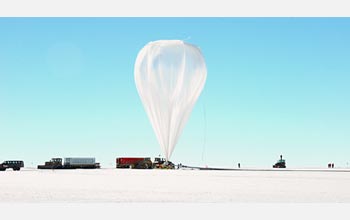|

Press Release 09-002
NSF, NASA Successfully Flight-Test New Balloon Over Antarctica

Intergency cooperation in Antarctica facilitates unique scientific observations over the southernmost continent
January 8, 2009
For B-roll of balloon-launch preparations near NSF's McMurdo Station, Antarctica, contact Dena Headlee at (703) 292-7739 or dheadlee@nsf.gov.
The National Science Foundation (NSF) and the National Aeronautics and Space Administration (NASA) have successfully launched and demonstrated a newly designed super pressure balloon prototype that will one day enable a new era of high-altitude scientific research. The super pressure balloon is expected to ultimately carry large scientific experiments to the brink of space for 100 days or more. "This flight test of NASA's seven-million-cubic-foot super pressure balloon is a very important step forward in building a new capability for scientific ballooning based on sound engineering and operational development," said W. Vernon Jones, NASA's senior scientist for suborbital research at NASA Headquarters in Washington. "While the team has a ways to go in scaling up the pumpkin balloon to be able to lift a one-ton instrument to a float altitude of 110,000 feet, the team has demonstrated they are on the right path". The super pressure balloon was highlighted in the National Research Council's decadal survey, "Astronomy and Astrophysics in the New Millennium," and will play an important role in providing inexpensive access to the near-space environment for science and technology. The test flight was launched Dec. 28, 2008, from McMurdo Station, NSF's logistics hub in Antarctica. NASA and NSF conduct an annual scientific balloon campaign during the Antarctic summer. NSF manages the U.S. Antarctic Program and provides logistic support for all U.S. scientific operations in Antarctica. In January 2008. the agencies jointly achieved a new milestone in the almost 20-year history of scientific ballooning in Antarctica by launching and operating three long-duration sub-orbital flights within a single southern-hemisphere summer. Unique atmospheric circulation over Antarctica during the austral summer allows scientists to launch balloons from a site near McMurdo Station and recover them from very nearly the same spot weeks later, after the balloons have circled the continent one to three times. Antarctic flights are of a long duration because of the polar vortex, a persistent, large, low-pressure system, and because there is very little atmospheric or temperature change. Constant daylight in Antarctica means no day-to-night temperature fluctuations on the balloon, which helps the balloon stay at a nearly constant altitude for a longer time. The newly tested balloon reached a float altitude of just over 111,000 feet and continues to maintain a nearly constant altitude into its eleventh day of flight. The purpose of this flight is to test the durability and functionality of the scientific balloon's unique pumpkin-shaped design and its novel material, a lightweight polyethylene film. The new material is a special co-extruded polyethylene film, about the thickness of ordinary plastic food wrap. "Our super pressure balloon development team is very proud of the tremendous success of the test flight and is focused on continued development of this new capability to fly balloons for months at a time in support of scientific investigations," said David Pierce, chief of the balloon program office at NASA Goddard Space Flight Center's Wallops Flight Facility, Wallops Island, Va. "The test flight has demonstrated that 100 day flights of large, heavy payloads is a realistic goal". The promise of ultra-long duration missions using the super pressure balloon is that the balloon cost is considerably less than a satellite and the scientific instruments flown can be retrieved and launched again. This 7 million cubic foot balloon is the largest single-cell, super-pressure (fully sealed) balloon ever flown. When development ends, NASA will have a 22 million cubic foot balloon that can carry a one-ton instrument to an altitude of just over 110,000 feet--three to four times higher than passenger planes fly. In addition to the super pressure test flight, two additional long duration balloons have been launched from McMurdo during this year's campaign. The University of Hawaii Manoa's Antarctic Impulsive Transient Antenna (ANITA) launched December 21 and is still aloft. Its radio telescope is searching for indirect evidence of extremely high-energy neutrino particles possibly coming from outside our Milky Way galaxy. The University of Maryland's Cosmic Ray Energetics And Mass (CREAM IV) experiment launched December 19 and landed January 6. The CREAM investigation was used to directly measure high energy cosmic-ray particles arriving at Earth after originating from distant supernova explosions elsewhere in the Milky Way galaxy. The Wallops Flight Facility manages NASA's scientific balloon program for NASA's Science Mission Directorate. Launch operations are conducted by the Columbia Scientific Balloon Facility, Palestine, TX, which is managed for NASA by the Physical Science Laboratory of New Mexico State University, Las Cruces.
-NSF-

Media Contacts
Dana W. Cruikshank, NSF (703) 292-8070 dcruiksh@nsf.gov
J.D. Harrington, NASA headquarters (202) 358-5241 j.d.harrington@nasa.gov
Betty Flowers, NASA Wallops Flight Facility (757) 824-1584 elizabeth.b.flowers@nasa.gov
Related Websites
Read the NSF news release "Scientific Balloons Achieve Antarctic Flight Record": http://www.nsf.gov/news/news_summ.jsp?cntn_id=110933
To learn more about the University of Maryland's CREAM IV experiment see:: http://cosmicray.umd.edu/cream
For information on NASA's Balloon Program see:: http://sites.wff.nasa.gov/code820
Track the flight path of the balloons: http://www.csbf.nasa.gov/antarctica/ice0809.htm

The National Science Foundation (NSF) is an independent federal agency that
supports fundamental research and education across all fields of science and
engineering, with an annual budget of $6.06 billion. NSF funds reach all 50
states through grants to over 1,900 universities and institutions. Each year,
NSF receives about 45,000 competitive requests for funding, and makes over
11,500 new funding awards. NSF also awards over $400 million in
professional and service contracts yearly.
 Get News Updates by Email Get News Updates by Email
Useful NSF Web Sites:
NSF Home Page: http://www.nsf.gov
NSF News: http://www.nsf.gov/news/
For the News Media: http://www.nsf.gov/news/newsroom.jsp
Science and Engineering Statistics: http://www.nsf.gov/statistics/
Awards Searches: http://www.nsf.gov/awardsearch/
| 

